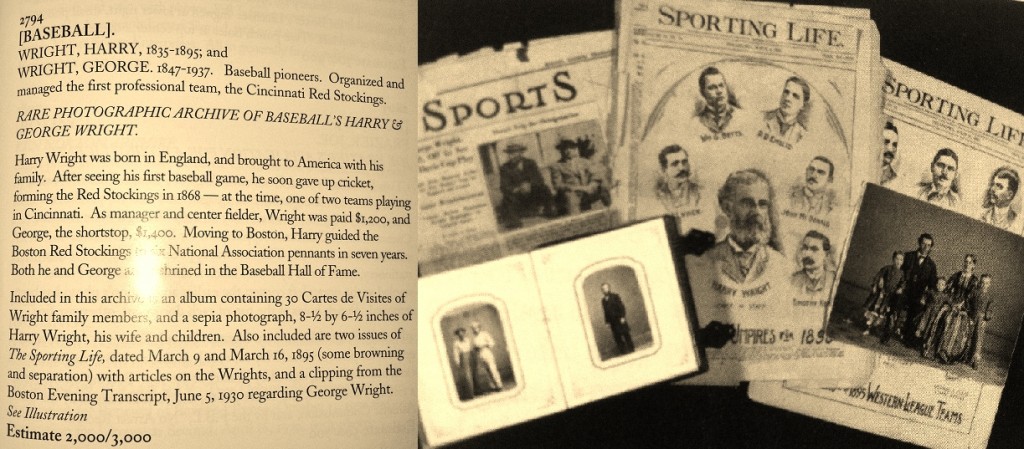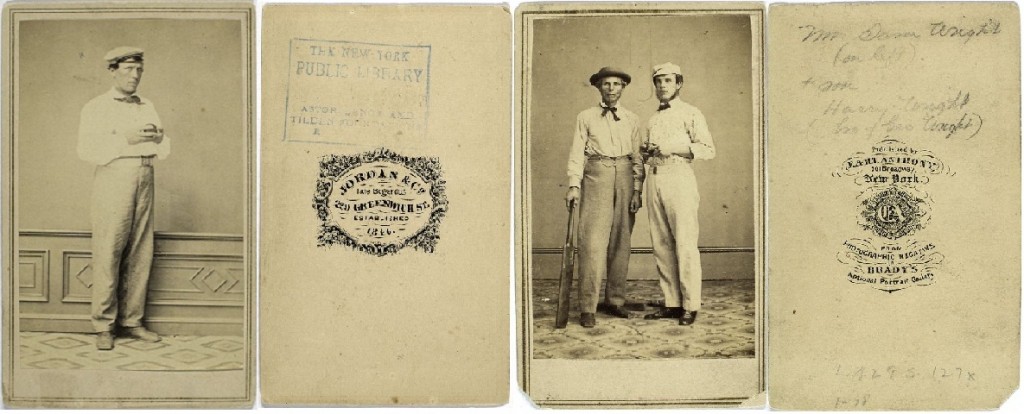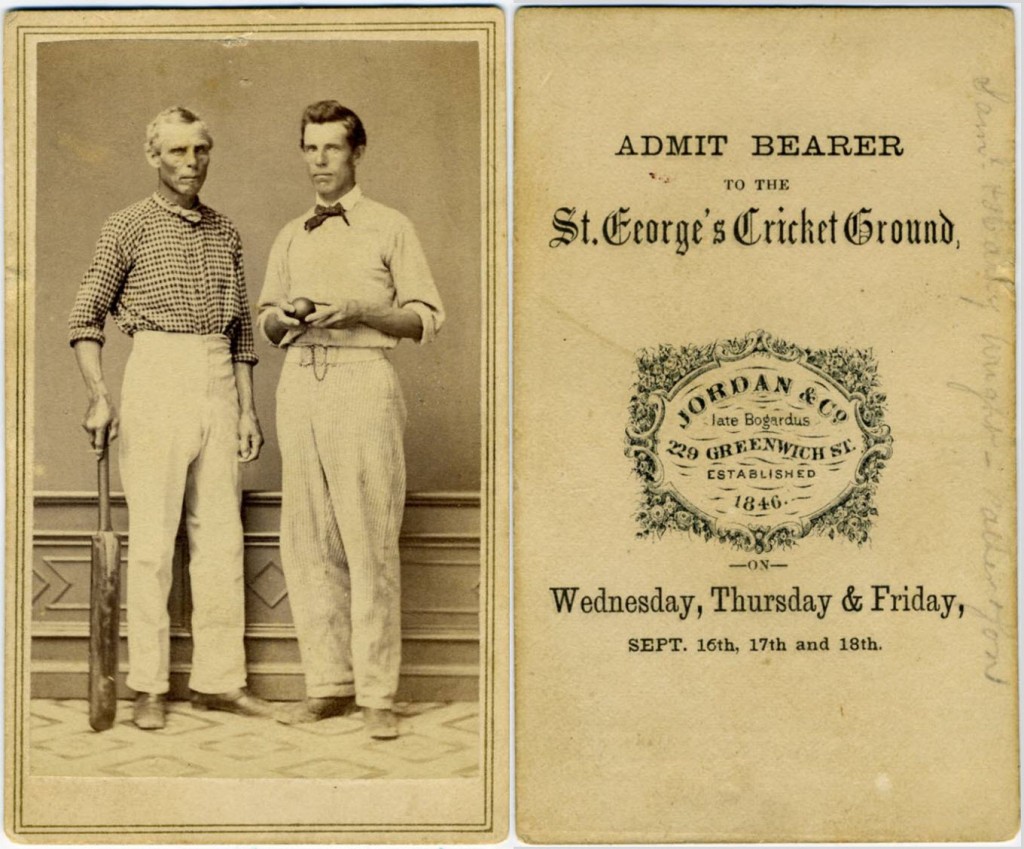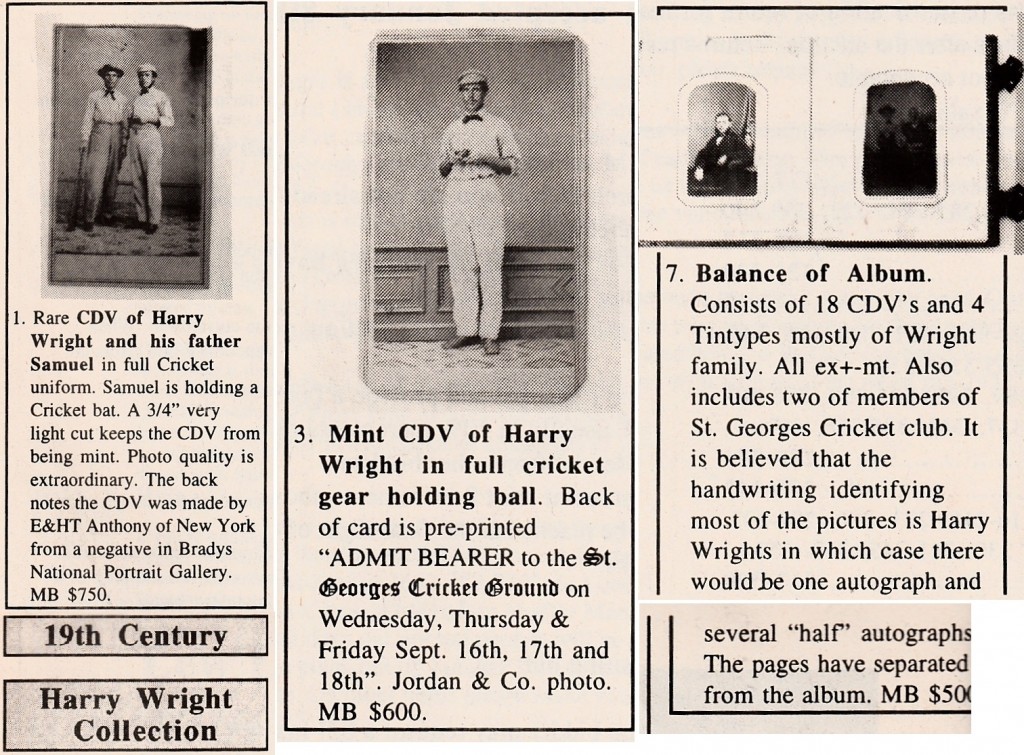By Peter J. Nash
May 6, 2013
Robert Edward Auctions has made quite a fuss over its offering of an 1863 cricket CDV of Harry Wright in an attempt to establish it as the “First Baseball Card.” REA president Rob Lifson goes on at length about the research his company has conducted to make the case that the CDV purchased for $83,543 by Keith Olbermann in a 2000 REA/MastroNet auction should be considered for the loftiest of titles in the card-collecting realm.
Lifson writes, “Because this card was the first card picturing a baseball player available to the general public (as well as the first printed for the purpose of promoting the commercial retail sale of a product to the public), it is by definition the very first baseball card.”
Lifson’s research is nothing ground-breaking or original, as most of it was already conducted by the consignor who placed the CDV with MastroNet to sell in 2000. It was the consignor who researched the New York Public Library’s “Harry Wright Notebooks” and discovered the entries related to the production of the Jordan & Co. CDV-cricket tickets.
In fact, a source familiar with REA’s own recent research at the NYPL says that Lifson did not view any library materials and asked librarians just one question. In his lot description, however, Lifson thanked NYPL librarians stating that they were “accommodating above and beyond, to the point of doing research for us.” There is a certain irony in Lifson’s recent claim as the auctioneer was once apprehended stealing similar CDV cards from the NYPL’s Spalding Collection in 1979 while attending the Wharton School of Business.
Based primarily upon the research conducted by the original consignor, Lifson made the same case for the Wright CDV back in 2000 when he sold it in the same auction as the now infamous Gretzky-McNall T206 Honus Wagner card. It was in that REA/MastroNet sale that several sources allege Lifson and his partner Bill Mastro defrauded winning bidder Brian Siegel because both men had full knowledge that Mastro had trimmed the Wagner card to enhance its condition and value a short time after both men purchased the card in a Long Island card shop in 1985.
Due to the fraudulent enhancement of the card, the Wagner should not have received its “PSA-8″ grade, but rather the much less desirable “PSA-Authentic” grade, which was assigned to the PSA-encapsulated Harry Wright CDV which Lifson now claims, “Unquestionably qualifies for the monumentally important status of “The First Baseball Card.” Like the trimmed T206 Honus Wagner, which Lifson once told the Wall Street Journal was the “Mona Lisa” of baseball cards, the Harry Wright CDV has received the royal treatment from the REA hype-machine. Lifson now adds, “Remarkably, this title only scratches the surface of its great historical significance.”
Lifson’s new research, however, fails to note that two other cards issued with the Wright CDV, of William Hammond and William Crossley could also lay title to the “First Card” based upon his criteria. Both Hammond and Crossley also played in the same “Grand-Match” baseball game that Harry Wright did in conjunction with the CDV-tickets.
REA adds in its full-auction description:
“In fact, accompanying this lot is a copy of a notice published in the base ball section of September 19, 1863 edition of The Brooklyn Daily Eagle under the headline “Out Door Sports – Base Ball” that reads “New York vs. Brooklyn – The match between the two nines of the above cities that was to have been played yesterday will be commenced at 2 P.M. on the St. George’s Grounds. Several cricketers are to play on the part of New York.” The “several cricketers” referred to as playing for New York against Brooklyn on September 19, 1863 are Crossley, Hammond, and Harry Wright.”
Despite this fact, Keith Olbermann is in agreement with Lifson and got peeved recently when the mainstream media erroneously published a myriad of reports stating that a CDV of the 1865 Brooklyn Atlantics team was the first actual baseball card. On his MLB Baseball Nerd blog Olbermann indicated that the Atlantic CDV, which sold for $92,000 at auction, should not be considered a baseball card. Olbermann wrote:
“So, the 1865 Atlantics carte de visite, while a great item, doesn’t meet the standard definition of a baseball card.
Even if it did it would be far from the earliest known card. There were six different photographic cards issued in 1863 that simultaneously:
A) advertised a tournament featuring the Brooklyn Excelsiors playing the famed New York Knickerbockers in the “Grand Match At Hoboken” along with two cricket competitions;
B) served as admission tickets to the matches; and
C) cost extra because the photographs were designed to be saved as souvenirs.
Those are baseball cards. The records of how many were sold even survives: 150 of future Hall of Famer Harry Wright, 57 of a player named Crossley, 47 of another named Hammond, and 11 of Harry’s father Sam. A fifth card later surfaced showing the Wrights together, and two different poses of Crossley are known.”

Keith Olbermann, a prolific collector of baseball cards, shows off his T206 Wagner to Tim Hudson (MLB.com); The Harry Wright CDV he bought in 2000 is currently for sale via Rob Lifson (right) who is shown bidding on the trimmed Gretzky Wagner at Christie's in 1996.
In its lot description REA expands upon Olbermann’s opinion and goes into great detail as to why the card should be considered the first, however, Lifson & Co. offer very little information about the provenance of the rare card it calls, “Of astounding significance, and long recognized as one of the earliest cards known to exist.”
Much like the shady origins of the Mastro-trimmed Honus Wagner card, the provenance of the Harry Wright CDV is equally dubious. While it has never been definitively confirmed where collector Alan Ray originally acquired the Wagner card or the printers sheet it was allegedly cut from, it has likewise never been determined where the Harry Wright CDV actually originated from. In 2000, Lifson wrote in a Sports Collectors Digest article that the Wright CDV was “In fact, the example saved by Harry Wright for his personal collection.”
In 2013, REA describes the journey of the CDV starting on the West Coast in the late 1990s stating:
“….in 1998 the card had been auctioned by legendary collector/dealer/auctioneer Lew Lipset (author of The Encyclopedia of Baseball Cards). In preparing this auction writeup, we contacted Lew Lipset to ask if he could help us with tracing any additional provenance, and Lew graciously provided us with the contact information of the consignor as well as a copy of the original auction (which included descriptions of the other items that accompanied the Harry Wright card and therefore provided additional information). We spoke to the consignor and learned that that the Harry Wright card was included in an album purchased at a (non-baseball related) Fine Books & Manuscripts auction conducted by Butterfield’s Auctions in California. (An original copy of this July 16, 1997 Butterfield’s Auction catalog accompanies). The entire lot, which included materials ranging in date from the 1860s to the 1930s, was sent to Lew Lispet for auction and was mostly sold intact, with the few more desirable items included offered separately. The materials obviously originated from a Wright family member as it contained mostly family photos and no baseball photos or content with the exception of two 1863 Grand Match At Hoboken Benefit cards (one of Harry Wright and one of Crossley), strongly suggesting the possibility that these very cards were personally used for admission to the grounds by members of the Wright family!“
With no supporting evidence, REA and Lifson appear to be suggesting that someone in Wright’s family or perhaps a close relative may have consigned the photo album to Butterfield’s in 1997 and that Lew Lipset received the Wright CDV and other items with the album as a consignment from a third party.
But in 2013, rare photographs and CDV’s of the “Father of Professional Baseball,” Harry Wright, immediately call to mind the myriad of missing portraits from Wright’s personal archive housed at the New York Public Library as part of the A. G. Spalding Baseball Collection. There are over twenty missing portraits and tintypes of Wright and close to two-thousand missing documents that were once housed in library scrapbooks made to secure his personal correspondence. In his last will and testament Wright bequeathed his entire baseball archive of papers and photographs to the National League so that it would constitute the “nucleus” of a collection that could one day be studied for insights into the game’s earliest days. Hall of Famer and National League president A. G. Spalding incorporated Wright’s archive into his own and after he passed away in 1915 his widow decided to donate the entire treasure trove to the NYPL.
In July of 2009 a “rare cache” of Wright’s stolen papers appeared in an MLB All-Star Game auction conducted by Hunt Auctions and several of the rare letters addressed to Wright were identified by historian Dorothy Seymour Mills as the exact same documents she held in her own hands while researching at the library in the 1950s. An FBI investigation was commenced and Jack Curry of The New York Times interviewed one of Harry Wright’s blood relatives, his great-great granddaughter, Pam Guzzi, and reported: “(Guzzi) said her family had few artifacts from Wright’s career. She said the family would be monitoring the situation.” She added, “It seems odd to me. Why would someone have them if they weren’t related to him? Why would they be in their grandmother’s attic?”

The Wright family CDV album containing what REA calls the "First Baseball Card" featuring Harry Wright mysteriously appeared in a Butterfield & Butterfield auction in California in 1997.
Guzzi and her side of the family retained just one relic from Grandpa Harry’s baseball-days, a rather beat up CDV photograph of his champion Cincinnati Red Stockings team of 1869. Aside from that item, Guzzi says the family had no other original photographs or documents from his career. It was her understanding that everything was donated after he passed away in 1895.
So, a Wright family photo album featuring some of the rarest Harry Wright CDVs in existence showing up in a Butterfield & Butterfield auction in 1997 is curious to say the least. When the CDV album was sold there was absolutely zero scrutiny or mention of where it originated. At the time collector Barry Halper still owned his entire collection which featured a wide array of stolen Wright materials ranging from CDVs, cabinet photographs and letters stolen from the NYPLs Wright Correspondence Collection. When Halper sold his collection in 1999 at Sotheby’s, with REA’s Rob Lifson as the head consultant, the market was inundated with stolen materials related to Harry Wright.

The NYPLs Spalding Collection currently includes four Jordan CDVs with backs denoting they are tickets to the 1863 matches at the St. George's Cricket Grounds. The 1922 inventory notes the inclusion of four unidentified CDVs and one identified as Sam Wright (top). The two CDVs below the Wright duplicates feature cricketer William Hammond.
The New York Public Library’s Spalding Collection inventory in 1922 included one entry designating, “Unidentified cricket player (Jordan & Co.) 4 photographs, 4 players” and another handwritten entry added by researcher Charles Mears later in the 1920s identifying an additional group; “Cricket players (4) unidentified,” on the same inventory page. Of the four unidentified photographs of “cricket players” identified in 1922, three had backs identifying them as the 1863 Jordan & Co. “tickets” to the St. George Grounds.

The NYPL collection also features one "non-ticket" Jordan CDV of an "unidentified" cricket player (Crossley) and a Brady CDV of Sam and Harry Wright that bears no NYPL ownership stamps on its reverse.
The fourth unidentified example of the Jordan & Co. CDV images is devoid of the “ticket back” and has just a generic “Jordan & Co.” back. Another cricket related image included in the Spalding holdings was an E. T. Anthony CDV shot by Matthew Brady of Harry Wright and his father Sam holding cricket equipment. All of the cricket CDVs are marked with NYPL stamps except for the Brady image which bears no ownership mark of the NYPL.
Based upon Charles Mears’ handwritten notations in one of the NYPLs 1922 master inventory booklets of the Spalding Collection there were four unidentified Jordan CDVs and separate entries for one (duplicate) Jordan CDV of Sam Wright (Wright, Sam) with his name identified in ink on the front and another entry for “Wright, Harry, and another. Cricket (New York , Anthony.),” which was the Brady image of Harry and his father Sam.

Researcher and collector Charles W. Mears (right) helped organize and inventory the Spalding Collection and added handwritten notations to one of the NYPLs 1922 inventory booklets. He noted (4) additional "unidentified" cricket player photos in addition to the (4) Jordan & Co. CDVs already identified in the volume.(Top, right) Mears identified other photos which Wright appeared in his own hand and initialed "CW Mears." (Bottom) (C. W. Mears Photo, Cleveland Public Library)
But in addition to those entries in the actual inventory, Mears added in his own handwriting additional notations which appear to suggest that one additional CDV of Harry Wright and Sam Wright was in the collection as well as “Cricket players (4) Unidentified.”
If we take Mears’ notes to encompass the entire cricket related CDVs in the Spalding Collection, it appears that the NYPL is missing another four unidentified cricket player photographs and one duplicate Anthony CDV of Harry and Sam Wright by Brady.(Mears did not identify the unidentified (4) cricket players as CDVs).
It also appears that the library is missing another extremely important artifact related to Harry and Sam Wright, the actual St. George’s Cricket Club’s “Register of Play,” the official score book of the club used between 1848 and 1867. That score book would have recorded the matches related to the production of Wright’s Jordan & Co. CDVs and may have offered more clues to researchers. The St. George volume, however, like so many other Wright-related artifacts, is missing from the Spalding Collection along with several important pages that were cut and wrongfully removed from the Knickerbocker Base Ball Club’s score book.

While the NYPL still retains this 1863 image of Henry Chadwick and Harry Wright at a St. George's Cricket Club match, Charles Mears' notes suggest there may be additional cricket photos missing from the NYPL's Spalding Collection along with the actual St. George's Cricket Club score book which recorded matches from 1848 to 1867. (Spalding Collection, NYPL)
In its lot description of the Wright CDV REA opines on the number of known Jordan & Co. cricket CDVs:
“Several other 1863 Grand Match At Hoboken Benefit card examples are known to exist (we believe fewer than ten in total are known to date), including two examples of Sam Wright and two of Crossley that are in the Spalding Collection at The New York Public Library, several additional examples of Crossley (including one that that was discovered by a non-collector in the midwest as recently as 2007!), one example featuring Harry and Sam Wright together (an astounding card with an image that has previously not been published or even seen and which is presented as the following lot in this auction) and at least one Hammond.”
Considering REAs claims of the staggering rarity of the Jordan & Co. CDVs, it would appear that a closer look at the population and provenance of the known examples is warranted.

This "newly discovered" Jordan & Co. CDV-ticket featuring Sam and Harry Wright appears for sale in REA's Spring Auction.
When Lifson sold the Wright Cricket-CDV as part of MastroNet in 2000 he said this about the provenance of the card:
“The only other examples known from this set, the existence of which we have become aware of during the process of researching this card, are a part of the Spalding Collection at The New York Public Library. Included in the Spalding Collection are two cards of Sam Wright, two of Crossley, (and none of Hammond or Harry Wright). It is interesting to note that this Harry Wright card was discovered in an album of photographs which surfaced in California in 1998. This album belonged to Harry Wright personally. The Harry Wright card offered in this lot was in fact the example saved by Harry Wright for his personal collection.”
It should be noted that Lifson had no evidence whatsoever to make such a claim, neither from Butterfield & Butterfield Auctions nor from a Wright descendant. In fact, Wright’s last will and testament specifically noted that his entire baseball and sports archive was to be bequeathed to the National League so as to form a “nucleus” of a collection to tell the story of the development of the game.

Harry Wright's 1895 codicil to his will, in his own hand, specifies that his executors bequeath pictures related to both cricket and baseball to the National League.
The codicil to Wright’s will (which has been stolen from a Philadelphia Courthouse and subsequently sold at Hunt Auctions) was executed on September 28, 1895:
“All of my books and memoranda bearing upon or concerning the National Game of Baseball, Cricket and other sports….including pictures and other valuable matter…..I give and bequeath unto the National League and American Association of Professional Base Ball Clubs and their successors in the sincere hope and wish that they may use them as a nucleus or beginning of a historical collection of memoranda and facts bearing upon our grand national game of baseball…”
As noted earlier, in the thirteen years that have transpired since Keith Olbermann’s purchase in 2000, Lifson’s story has changed to this:
We spoke to the consignor and learned that that the Harry Wright card was included in an album purchased at a (non-baseball related) Fine Books & Manuscripts auction conducted by Butterfield’s Auctions in California. (An original copy of this July 16, 1997 Butterfield’s Auction catalog accompanies). The entire lot, which included materials ranging in date from the 1860s to the 1930s, was sent to Lew Lispet for auction and was mostly sold intact, with the few more desirable items included offered separately. The materials obviously originated from a Wright family member as it contained mostly family photos and no baseball photos or content with the exception of two 1863 Grand Match At Hoboken Benefit cards (one of Harry Wright and one of Crossley), strongly suggesting the possibility that these very cards were personally used for admission to the grounds by members of the Wright family!”

Lew Lipset offered the Harry Wright CDV in 1998 with a minimum bid of $600 and identified the entire offering as "The Harry Wright Collection."
First Lifson stated it belonged to Wright, personally, and then theorized that it was once in the possession of a “Wright family member.” The first attribution to Harry Wright specifically was noted in 1998 when Lew Lipset sold the group of material as the “Harry Wright Collection.” The basis for that determination at the time was, perhaps, related to Lipset stating:”It is believed that the handwriting identifying most of the pictures is Harry Wright’s.”
Based upon the album’s alleged ties to Harry Wright and the Wright family is it possible that the Olbermann-Harry Wright CDV originated from the Spalding Collection and is one of the photos Charles Mears noted was missing from the NYPL? Or could it have originated with Harry’s brother, George, or one of his family members? And regardless of the origins of the CDV, who actually consigned the Wright materials to Butterfield & Butterfield and to Lew Lipset?
Despite the hoopla in the auction description, which calls the Harry Wright CDV “The First Baseball Card,” REA is still seeking an opening bid of $50,000. Haulsofshame.com contacted Keith Olbermann to confirm whether or not he is the current consignor of the Wright CDV to the REA sale. Olbermann, a well-known and prolific collector, did not respond to our inquiry but sources indicate that it is more likely that he may have previously traded or sold the card to acquire another item he desired. Several sources said Olbermann rarely, if ever, has sold items from his impressive collection.
Watch for our next report about the “Dubious Provenance of the Olbermann-Harry Wright CDV.”
